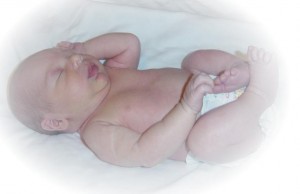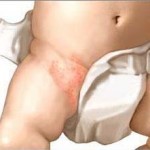Newborn Skin Conditions and Rash Problems
 Giving birth to a baby is a painful and anxious process for a mother. For the baby it is a torture. For nearly 40 weeks it lies in its cozy bed, floating and somersaulting in the water around. It does not have to see anything, hear any sound have to sit up for lunch or squat for passing stools. All it has to do is to sleep and sleep while occasionally kicking the mother to keep her awake.
Giving birth to a baby is a painful and anxious process for a mother. For the baby it is a torture. For nearly 40 weeks it lies in its cozy bed, floating and somersaulting in the water around. It does not have to see anything, hear any sound have to sit up for lunch or squat for passing stools. All it has to do is to sleep and sleep while occasionally kicking the mother to keep her awake.
At the time of delivery the strong contractions of the uterus squeeze the fetus awake. The moment the child is born it is overwhelmed by the stimulation of all its sense organs. There is the sound of the mother screaming the nurse chatting. Smell of the delivery room fills its nostrils, bright light enters the eyes.
As if all this were not enough, the nurse also gives a slap and holds the 3 kg bundle upside down to make it cry. Imagine the agony of this individual whose fundamental rights are being violated right from day one.
From the moment the child ‘steps’, it is exposed to a wide variety of factors in the environment. Sunlight, wind, weather, harmful, chemicals in the form of soaps oils powders etc. dirt, dust, insects and of course all sorts of microorganisms. Before we go onto the numerous diseases affecting the skin of an infant, let us look at some of the normal variations seen in a newborn.
Newborn baby skin conditions in early days
Cheesy Coat: At birth the skin is covered with a whitish greasy material known as vernix caseosa. This material is composed of fat derived from the glands of the skin. In some babies, it is present only in the body folds. It usually dries rapidly and can be easily washed off.
Blue Lips: The palms, soles and the area around the mouth may appear blue in the newborn baby. This may remain for nearly 48 hours. However, if the baby’s tongue also appears blue, it suggests some associated illness which will require further tests.
Funny color change: A very peculiar skin colour change occurs in the newborn When the baby is made to lie down on one side, a striking colour difference appears along the midline of the body. The upper half appears pale and the lower half is deep red with a sharp demarcation along the midline. If the baby is turned to the other side, the color change is reversed. This is called ‘harlequin color change’ and may last from half a minute to 20 minute. This change usually does not persist beyond 4 weeks. If it does, then the baby should be taken to a child specialist to check if anything is seriously wrong.
Newborn peeling skin: The skin over the ankles may starts peeling in some babies. In others, peeling may be seen over large areas.
Thumb sucking in the womb: One or two raw areas or blisters may be seen on the fingers, lips or forearms of newborn babies. This is thought to be caused by vigorous sucking by the baby while in the mother’s womb.
Mini Puberty: The effect of maternal hormones on the baby may result in “miniature puberty”. That is, there may be watery vaginal discharges, the genitals may appear fleshy and there may be bleeding from the uterus in a newborn girl.
Witchs’ Milk: Newborns of both sexes may have swelling of the breast and milk (witchs’ milk) may be released after 2-3 days of birth. The swelling usually subsides during the 2nd week but in some girls it may persist, there is a likelihood of on faction. All these are normal variations seen in newborn babies. Parents should be aware of these changes so that they do not become anxious.
Newborns have a very delicate skin which is easily damaged when irritated. Skin rashes in babies can be minimized by following some simple precautions. Never take these rashes lightly as they may cause serve distress to the little child.
Newborn baby skin rashes (1-5 days)
Toxic Erythema of newborn: Within 2-5 days of birth the newborn may develop reddish blotches in some parts of the body. These enlarge and join together to form large sheets of red coloured skin. Occasionally, small blisters fluid for pus may be seen. This is known as toxic of the newborn. This condition is considered to be mild of the skin to the secretions in the mother’s birth canal. The child may have some discomfort. It does not require any treatment as it passes off within a few days. The child should be given normal feeds and the mother need not worry that it is an infection.
Prickly Heat: This is a very common condition seen in children of all ages. Pin point red eruptions, sometimes filled with may be seen in the folds of the neck, groin or even on the trunk. It results from blockage of tubes (duct) carrying sweat due to which the tip of the tube appears elevated. Tightly wrapping the newborn and excessive oil massage are the common causes of prickly heat in newborn.
If your child already has a skin rash, stop all local application. Oil massage should be discontinued immediately. Quite often older members of the family do not agree with this, yet all massages should be stopped for the time being. The child should be allowed to lie down with some fine cotton clothing in a cool surrounding. The rash will disappear in a few days.
Cradle Cap: In some infants the oil production on the scalp is excessive and tends to irritate the skin. The skin becomes red and thick. Crust get heaped up. Removing crusts is painful and difficult. In the first 3 months, a large number of hormones derived from the mother persist in the child’s blood. As a result some of these stimulate the oil producing sebaceous glands in the scalp of the newborn. A good bath will take care of crust. Soak the crust and apply baby soap gently. Once the crust becomes soft, it will come off easily. The entire mass should not be removed in one session as otherwise it will leave a raw area on the scalp.
A mild corticosteroid cream (Flucort) can be applied if advised by the skin specialist. Massaging of coconut oil or mild creams will also soften the crusts.
Note: Creams and ointments which are easily available over-the-counter can cause great harm to the child’s skin. Strong steroid creams (Clop, Betnovate, Tenovate etc.) thin down the baby’s delicate skin and sometimes also produce white patches. Hence, never apply any cream without your doctor’s advice.
 Newborn diaper rash: As the name suggests it is an inflammatory eruption of the napkin area. A wide variety of factors are responsible for napkin rash, for example:
Newborn diaper rash: As the name suggests it is an inflammatory eruption of the napkin area. A wide variety of factors are responsible for napkin rash, for example:
- Friction between the skin and diaper.
- Softening of the skin due to frequent wetting with urine and stool.
- Soaps, detergents and antiseptics.
- Fungal infection may further complicate the inflammation.
- The lower abdomen, genitals, buttocks, upper thighs and groin folds appear fiery red. Cracks may appear in the skin along the groin folds. The infant cries when the legs are pulled straight as the crack widens.
- Additional infection by a fungus, Candida albicans will produce a cheesy like discharge from the area. The thighs and lower abdomen may be studded with pus filled eruptions surrounded by a red colored ring.